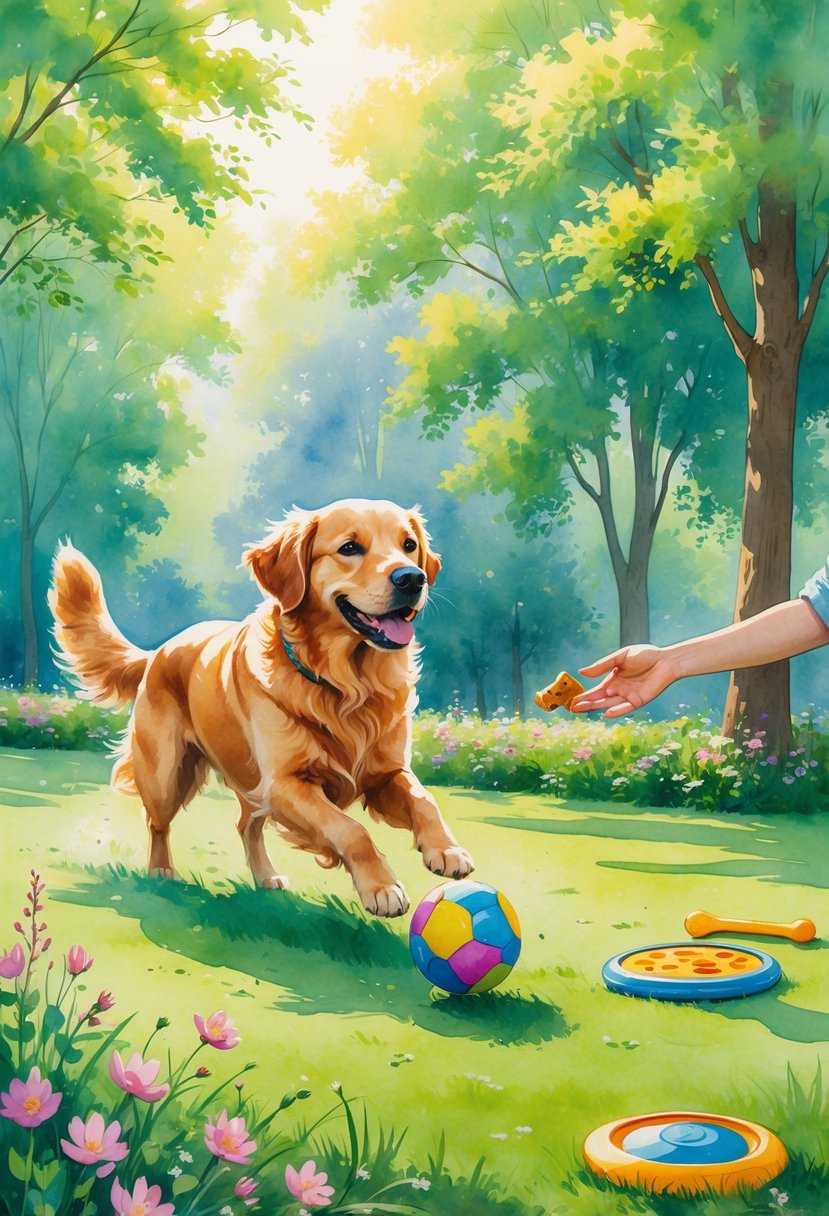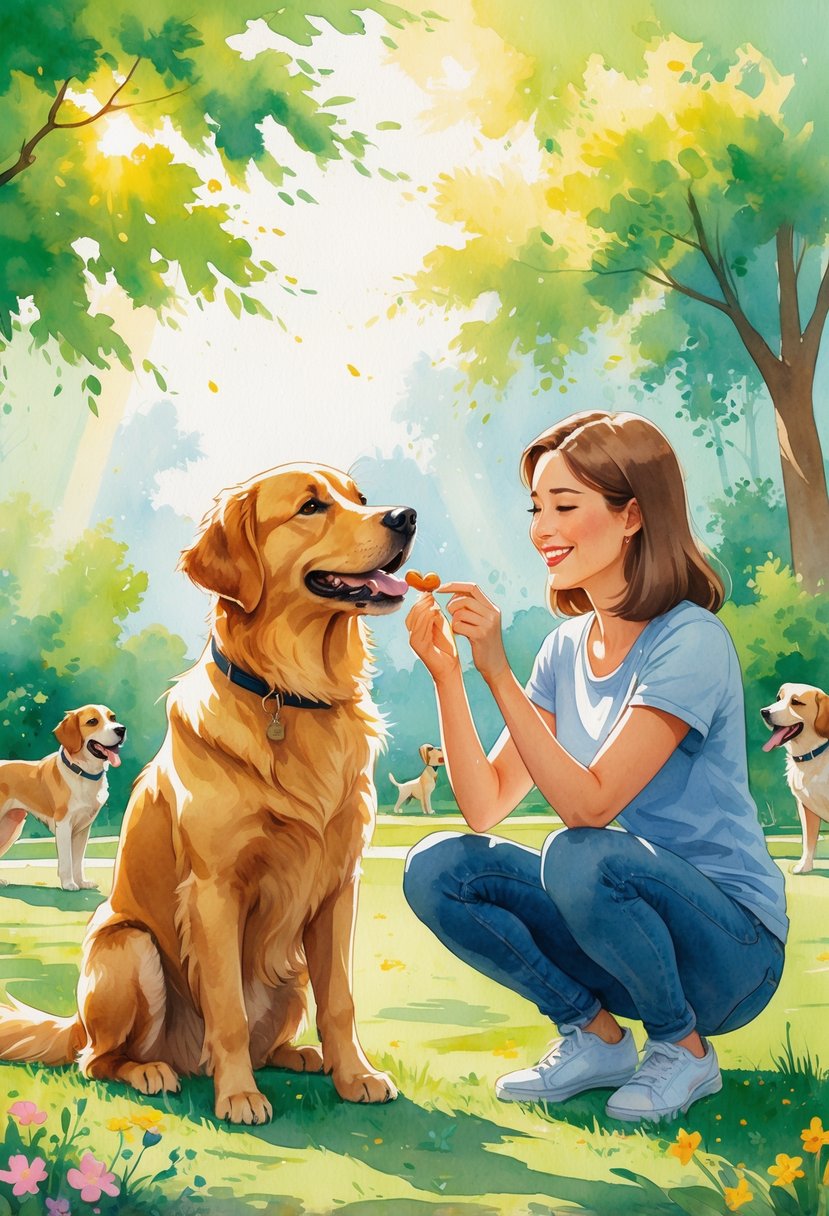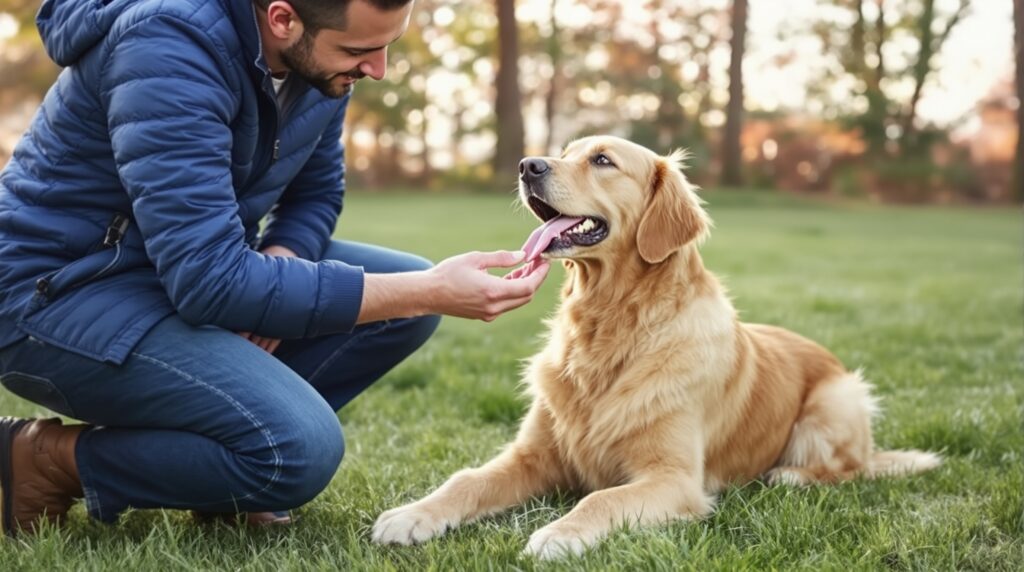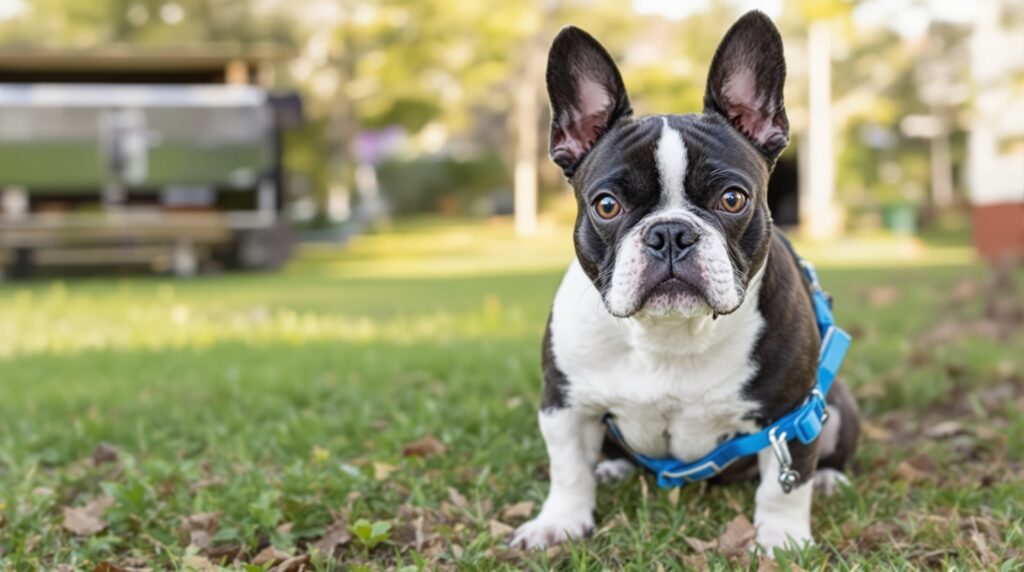Training a Golden Retriever can feel overwhelming, but honestly, it doesn’t have to be. These dogs are smart, eager to please, and they respond way better to rewards than punishment.

You don’t need fancy gadgets or harsh methods. With the right approach, you can guide your dog to follow commands, behave in public, and actually enjoy learning.
Simple things like consistent cues, timely rewards, and keeping sessions short make a huge difference in how fast your Golden learns. When you know how to use rewards well, training feels less like a chore and more like something you both look forward to.
Key Takeaways
- Positive reinforcement builds trust and good behavior
- Consistency and clear cues make training easier
- Rewards and stimulation keep your Golden engaged
Understanding Positive Reinforcement for Golden Retrievers
Golden Retrievers learn best when you reward good behavior instead of punishing mistakes. Using treats, toys, or praise makes training more effective, keeps your dog motivated, and tightens your bond.
What Is Positive Reinforcement?
Positive reinforcement means you add something your dog loves right after they do what you want. This could be a tiny food reward, a favorite toy, or just saying “good job.”
The goal is to help your dog connect the action with the reward. If your Golden sits on command and you give a treat right away, they’ll quickly learn that sitting leads to something good.
Timing is everything. You’ve got to give the reward within a few seconds so your dog links the behavior and the treat.
You can also use a marker, like a clicker or a cheerful “yes,” to show the exact moment your dog gets it right. This makes things clearer and speeds up learning.
Why Golden Retrievers Respond Best to Positive Methods
Golden Retrievers are eager to please, friendly, and honestly, a little sensitive. Harsh training or punishment can make them nervous and less willing to try new things.
Positive reinforcement works better because it builds on their natural desire to make you happy. They love attention, food, and play, so these rewards keep them coming back for more.
Consistency matters a lot. If you reward a behavior sometimes but ignore it other times, your dog may get confused.
Because they’re smart and social, Goldens thrive when training feels like a game. Keeping sessions short and fun helps them stay excited to learn.
How Positive Reinforcement Builds a Stronger Bond
When you use positive reinforcement, your dog starts to see you as the source of all good things. This creates trust and makes your Golden more likely to listen in different situations.
Rewards like playtime or affection show your dog you value their effort. It teaches obedience, sure, but it also deepens your connection.
Training turns into a way to communicate, not just a list of commands. Over time, your Golden learns to look to you for guidance and feels safe following your lead.
Establishing a Consistent Training Routine
A steady training routine helps your Golden Retriever know what you expect. When you keep rules clear and sessions short but regular, your dog stays focused and motivated.
Setting Clear Rules and Expectations
Your Golden learns faster when you stick with the same rules. If you let a behavior slide one day but correct it the next, your dog will get confused.
Use the same words, tone, and hand signals for each command. Always say “sit” instead of bouncing between “sit down” and “sit.” Repeating cues helps your dog make strong associations.
It helps to get everyone in your household on board. If one person lets the dog on the couch and another doesn’t, training will slow down.
Think of your rules as a guide that helps your dog feel secure. When your Golden knows what to expect, they can focus on learning.
Scheduling Short and Engaging Sessions
Goldens love to learn, but long sessions can overwhelm them. Aim for 5–10 minute training sessions a few times a day.
Start in a quiet space with few distractions. As your dog gets better, add new places so they learn to listen anywhere.
Make each session fun by mixing in play or a quick game. Reward success right away with a treat or some happy words.
Try to train around the same times each day, like after meals or walks. This builds a routine your Golden can count on.
Mastering Basic Obedience Commands
Teaching your Golden basic obedience commands builds trust and makes daily life way easier. These skills help you guide your dog in different situations and give your pup some structure.
Sit and Stay
“Sit” is usually the first command because it sets the stage for everything else. Hold a treat above your dog’s nose and move it back until they sit, then reward right away.
“Stay” builds patience and self-control. Start with just a few seconds, then slowly add time and distance. Always release your dog with a clear word like “okay” so they know when they’re free.
Both commands are super useful in real life. Practicing daily in short bursts helps your Golden understand that these cues aren’t optional.
Come and Leave It
“Come” is a top safety command. You want your dog to return no matter what’s going on around them.
Begin indoors with a happy voice and lots of praise when your dog comes to you. Gradually practice outside using a long leash before trying off-leash.
“Leave it” teaches your Golden to ignore food, objects, or even other animals. Start by placing a treat in your hand, letting your dog sniff, and rewarding them only when they back away.
Whether it’s calling your dog back at the park or stopping them from eating something gross, these skills make life safer and less stressful.
Down and Heel
“Down” helps your Golden settle in busy places. Use a treat to guide your dog into position, then reward once they stay down.
“Heel” keeps your dog walking calmly by your side. Start with short distances, rewarding your Golden for sticking close without pulling.
Over time, increase the duration and try different walking speeds. These commands make walks more enjoyable and help your Golden focus on you instead of the world.
Rewarding Good Behavior Effectively

When you reward desired behaviors the right way, your Golden learns faster and stays motivated. The kind of reward and how you give it both matter a lot.
Choosing the Right Rewards
Not every Golden is motivated by the same thing. Some love food treats, while others get more excited about a favorite ball or toy.
Pay attention to what your dog loves and use that as the main reward. Keep treats small, soft, and easy to chew so you can hand them out quickly.
Save higher-value rewards, like a special toy or tastier treat, for tougher tasks.
Mix rewards to keep things interesting. For example:
- Food treats: Small bites of chicken, cheese, or store-bought training treats
- Toys: A quick game of fetch or tug
- Praise: Upbeat words like good job or yes
Rotating rewards helps prevent boredom and keeps training fresh.
Timing and Consistency in Rewards
Timing is just as important as the reward itself. Give it right after your Golden does what you want.
Even a few seconds’ delay can confuse your dog and weaken the connection. Consistency is huge. If you reward sit one time but not the next, your dog won’t know what you expect.
Use short, clear cues and always follow through. For example, if you ask for stay and your dog holds it, reward right away.
Over time, you can use fewer treats and rely more on praise or play. This keeps the behavior strong without making your dog totally dependent on snacks.
Incorporating Mental and Physical Stimulation

Your Golden Retriever needs both movement and brain work to stay balanced. Regular activity keeps their body fit. Problem-solving tasks prevent boredom and unwanted behavior.
Physical Exercise for Golden Retrievers
Goldens have a ton of energy, so daily exercise is a must. A walk is good, but usually, they need more than that.
Aim for at least 60–90 minutes of activity each day. Mix up the routine to keep things interesting.
Try long walks, fetch in the yard, or swimming. Swimming is especially great—it’s easy on their joints but still gives them a solid workout.
If you like running or hiking, your Golden can be an awesome companion. Just build up their stamina slowly and always bring water.
A sample weekly routine might look something like this:
| Day | Activity | Duration |
|---|---|---|
| Mon | Walk + fetch | 60 min |
| Wed | Swim | 45 min |
| Fri | Hike | 90 min |
| Sun | Walk + tug play | 60 min |
Switching up their exercise helps prevent restlessness and keeps them eager for the next outing.
Mental Stimulation With Puzzle Toys and Games
Mental stimulation matters just as much as exercise for Golden Retrievers. These dogs are smart and actually enjoy figuring things out.
Without enough challenges, they might chew, bark, or dig just to pass the time. That’s not fun for anyone.
Puzzle toys make it easy to keep your dog’s mind busy. Food-dispensing balls, treat mazes, and toys with hidden compartments all encourage them to think and work for rewards.
Start with simple puzzles and move up as your dog gets the hang of it. No need to rush—let them enjoy the process.
Interactive games are another way to give your dog’s brain a workout. Try a game of hide-and-seek with treats or toys.
You can also teach new commands that go beyond “sit” and “stay.” Short, upbeat training sessions can double as learning and bonding time.
Switch up which toys you leave out every few days. This makes familiar toys feel brand new and keeps your dog interested.
When you blend puzzle toys, games, and training, you end up with a Golden who’s tired in all the right ways.
Addressing Common Behavioral Challenges

Golden Retrievers sometimes pick up habits like jumping, barking, and chewing. You can guide these behaviors with consistency, redirection, and rewards for calm choices.
Preventing Jumping and Barking
Jumping usually means your dog’s just excited to see you or your guests. Instead of scolding, ask your Golden to sit before you give any attention.
Reward calm sitting with a treat or a gentle pat. Over time, your dog will figure out that keeping all four paws on the floor is the way to go.
Barking comes from boredom, attention-seeking, or alerting you to something. First, try to figure out what’s causing it.
If your dog barks for attention, don’t respond until they’re quiet. Then hand over a treat for the silence.
For alert barking, use a cue like “sit” and reward the calm.
Daily exercise helps a lot. A worn-out dog is much less likely to bark or jump too much.
Short, fun training sessions mixed with walks or playtime help burn off extra energy.
Quick tips:
- Use a consistent command like “off” for jumping.
- Give treats for quiet moments.
- Offer toys and enough exercise to keep energy in check.
Managing Chewing and Destructive Behaviors
Chewing is normal, especially for puppies, but it can turn destructive fast. Offer safe chew toys and praise your dog when they use them.
If you catch them chewing something they shouldn’t, just redirect them to a toy instead of scolding.
Crate training helps when you can’t supervise. The crate gives your dog a safe spot and keeps your shoes safe, too.
Make the crate cozy with a blanket and a safe chew toy inside.
Bored dogs chew more. Rotate toys to keep things interesting, and add puzzle feeders for extra mental work.
Chewing needs an outlet, so give your dog good options and you’ll avoid most headaches.
Helpful reminders:
- Redirect, don’t punish.
- Use crate training for safe downtime.
- Swap out toys to keep your dog interested.
Enhancing Social Skills Through Positive Reinforcement

Your Golden Retriever learns how to act around people, other dogs, and new places by having lots of different experiences. If you pair these with positive reinforcement, you can shape calm, confident, and polite behavior.
Effective Socialization Techniques
Introduce your Golden Retriever to new people, dogs, and places in short, positive bursts. Keep first meetings low-key, and use treats, toys, or praise when your dog stays relaxed.
Rewarding these moments helps your dog connect good feelings with social experiences.
Try socialization in everyday spots like parks, pet-friendly stores, or on neighborhood walks. Pair leash training with these outings to practice polite walking and cut down on pulling when distractions pop up.
A loose leash and calm hello always deserve a reward.
When introducing your dog to other dogs, go one-on-one in a neutral spot. Take it slow, and don’t push it.
Always end on a positive note. With time, your dog will realize that friendly behavior pays off, and staying calm is the goal.
You can also mix in low-pressure activities like agility training or puzzle games with other dogs around. That helps your Retriever focus and listen, even when life gets a little exciting.
Building Confidence in New Situations
Golden Retrievers really do best when they feel safe. Use positive reinforcement to spark curiosity, but don’t force them into anything.
If your dog seems unsure in a new place, try rewarding small things—like sniffing around or just sitting quietly. Those little wins build trust and reduce fear.
Get into the habit of bringing your dog to different spots. Think car rides, busy sidewalks, maybe even an agility course if you’re feeling ambitious.
Every time you introduce a new place, pair it with a reward for calm behavior. Over time, your dog starts to see unfamiliar spots as safe and maybe even fun.
A simple praise + treat system usually does the trick. For example:
| Situation | Reward Example |
|---|---|
| Calm in a crowd | Verbal praise + small treat |
| Walking past distractions | Gentle pat + food reward |
| Exploring new object | Click + treat |
Step by step, this builds confidence. Your Retriever gets calmer and more adaptable, and honestly, outings feel a whole lot smoother for both of you.



